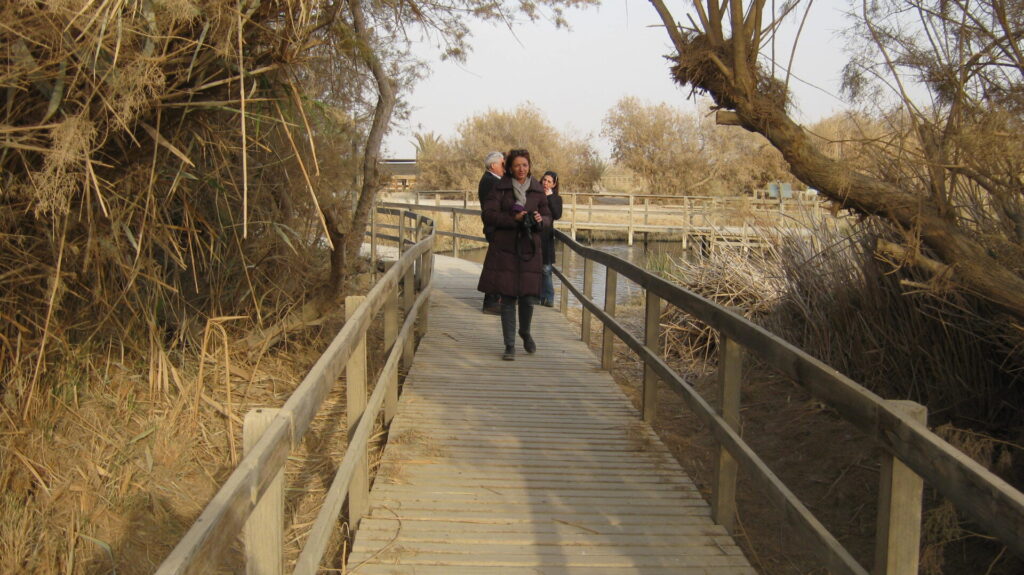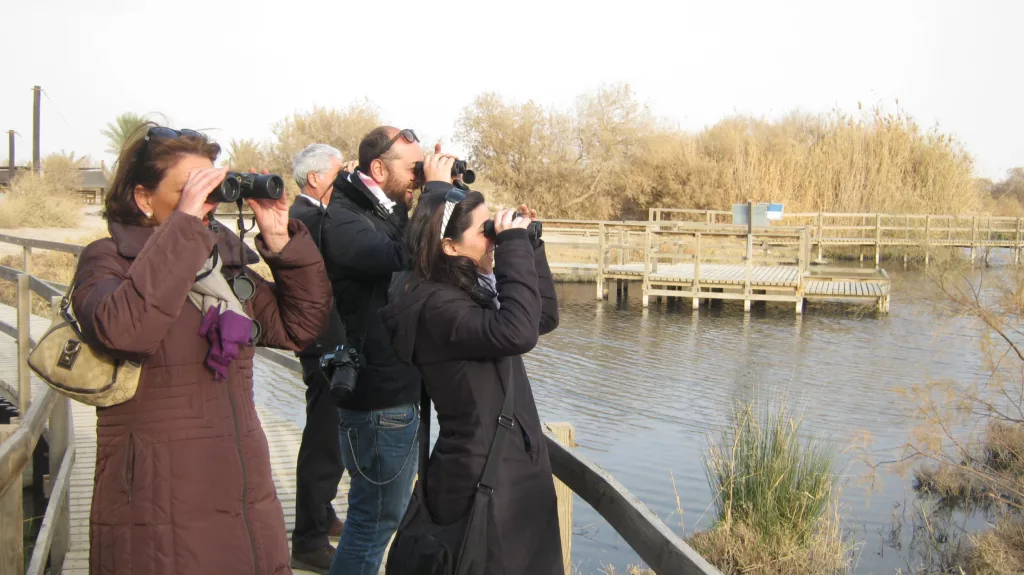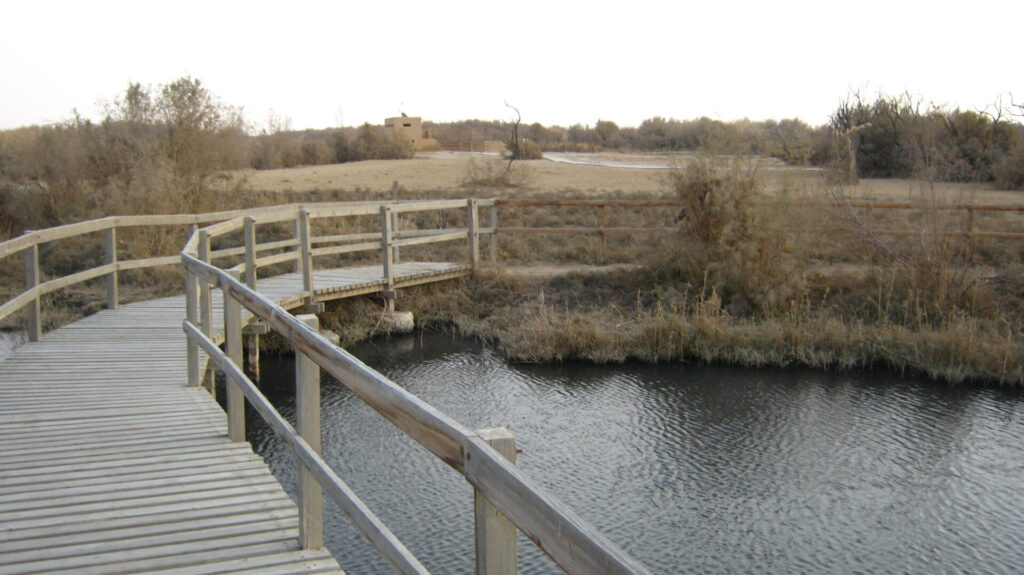


Azraq Wetland Reserve is a unique wetland, located in the heart of the arid Eastern Desert,
which takes its name from the Arabic word for ‘blue’.
A migratory stopover for birds from three continents, Azraq is becoming increasingly popular for bird watching.
From the walkways and hides, visitors get the chance to observe birds close at hand, including local, Jordan Tour
migratory, and occasional rare species.
Azraq Wetland Reserve, The Azraq area also has a rich cultural history due to its strategic location and water resources. Jordan Tour
It was used as a station for pilgrims and camel trains and Lawrence of Arabia was stationed in Azraq Castle during the
Arab Revolt. The local people are also unusually diverse, coming from three different
Azraq Wetland Reserve, Many interesting archaeological sites lie within easy reach of Azraq Lodge,
including the famous but misnamed ‘desert castles’: Qasr Amra, Qasr Kharana, and Azraq Castle.
Qasr Amra is one of the best-preserved Umayyad bathhouses in the world and a World Heritage Site.
Its interior walls are covered in lively frescos dating back to 700 AD.
There are also many dramatic desert landscapes to discover, including moon-like plains of black basalt and white valleys of chalk.
Jordan, often celebrated for its ancient ruins and dramatic desert landscapes, harbors a truly unique and ecologically significant treasure: the Azraq Wetland Reserve. Located in the eastern part of the country, this remarkable oasis stands as a testament to nature’s resilience, providing a critical lifeline for a diverse array of flora and fauna in one of the world’s most arid regions. Far more than just a body of water, the Azraq Wetland Reserve is a complex ecosystem, a historical crossroads, and a crucial beacon of conservation in the face of profound environmental challenges. Its story is one of natural wonder, human dependence, and the ongoing struggle to preserve a dwindling natural heritage.
The Azraq Wetland Reserve derives its name from the Arabic word “Azraq,” meaning “blue,” a fitting description for the once-vast expanse of shimmering water that contrasted dramatically with the surrounding black basalt desert. Historically, the Azraq Oasis was a sprawling system of permanent and seasonal marshes, fed by underground springs that tapped into the vast Azraq Basin aquifer. This unique hydrological feature created a mosaic of habitats, including shallow pools, reedy marshes, and muddy flats, supporting an astonishing level of biodiversity for a desert environment.
Ecologically, the reserve’s primary significance lies in its role as a vital stopover point for millions of migratory birds traversing the African-Eurasian flyway. Species ranging from garganeys and greater flamingos to various waders and birds of prey pause here to rest and refuel during their arduous journeys between breeding grounds in Europe and Asia and wintering grounds in Africa. The rich invertebrate life, abundant fish population, and diverse aquatic vegetation provide the necessary sustenance for these avian visitors. Beyond migratory birds, Azraq is home to several resident species, including the critically endangered Azraq Killifish (Aphanius sirhani), an endemic species found nowhere else on Earth. Its survival is intrinsically linked to the health and persistence of the Azraq waters. The wetland also supports a unique assemblage of amphibians, reptiles, and mammals, all adapted to this delicate interplay of water and desert. The flora, though seemingly less diverse than the fauna, includes important salt-tolerant plants and various reeds that form the structural backbone of the marsh ecosystem, providing shelter and nesting sites.
For centuries, Azraq functioned as a natural “water tower” for eastern Jordan, supplying water not only to its immediate surroundings but also indirectly supporting regional agriculture and human settlements. Its very existence defied the harsh desert climate, creating a microclimate that fostered life and sustained communities for millennia. The intricate web of life within the Azraq Wetland Reserve underscores its irreplaceable value as a natural heritage site, a living laboratory for hydrological and ecological studies, and a critical component of regional biodiversity.
The allure of water in an arid land naturally drew human presence to Azraq for millennia. Archaeological evidence suggests continuous human habitation around the oasis dating back to the Lower Paleolithic period, with tools and remnants indicating early human hunter-gatherer societies thrived here. The strategic location of Azraq, positioned at the intersection of ancient trade routes connecting Mesopotamia, the Arabian Peninsula, and the Levant, further cemented its historical importance. It served as a crucial waypoint for caravans, a resting place for pilgrims, and a strategic military outpost throughout various epochs.
Notable historical structures within and around the Azraq Wetland Reserve bear witness to this rich past. Qasr Azraq, a striking black basalt fortress, stands prominently near the modern town. Originally a Roman fort, it was later used by the Umayyads and Mamluks, and famously served as the headquarters for T.E. Lawrence (Lawrence of Arabia) during the Arab Revolt in the early 20th century. His vivid descriptions of the oasis in “Seven Pillars of Wisdom” further cemented Azraq’s place in modern history, highlighting its strategic value and the stark beauty of its environment.
Beyond these grand historical narratives, Azraq has long been interwoven with the lives of local Bedouin communities. For generations, they relied on the oasis for water, grazing land for their livestock, and sources of food and medicinal plants. The relationship between the people and the wetland was one of profound interdependence, shaping local culture, traditions, and livelihoods. This long history of human interaction, while at times impacting the environment, also showcases the vital role the Azraq Wetland Reserve played in sustaining human civilization in an otherwise unforgiving landscape.
The mid-20th century marked a dramatic turning point for the Azraq Wetland Reserve. Rapid population growth in Jordan, particularly in the capital Amman, led to a surge in demand for water. The seemingly endless supply of water from the Azraq aquifer became a primary source, leading to massive over-extraction through deep boreholes. The devastating consequences became evident in the 1980s and 1990s: the once-vibrant marshes began to shrink at an alarming rate, and by 1993, the permanent springs had dried up completely, leaving behind a parched, cracked landscape where a thriving wetland once stood. The Azraq Killifish teetered on the brink of extinction, and migratory bird numbers plummeted.
Recognizing the ecological catastrophe unfolding, the Royal Society for the Conservation of Nature (RSCN), a leading Jordanian NGO, stepped in. In 1978, the Azraq Wetland Reserve was established to protect what remained and initiate restoration efforts. The primary challenge was clear: restoring the water. Since 1994, the RSCN has spearheaded an ambitious rehabilitation program focused on artificial rewetting. Water is pumped from deep wells (from the same aquifer, but managed carefully) into specially constructed pools and channels within the reserve, mimicking the natural flow and creating a semblance of the original wetland environment. This strategy has allowed for the slow but steady recovery of some portions of the wetland, providing critical habitats for birds and other wildlife.
Beyond rewetting, conservation efforts at Azraq encompass a multifaceted approach. Habitat rehabilitation involves managing vegetation, controlling invasive species, and creating diverse microhabitats. Strict protection measures are in place to prevent hunting and ensure minimal disturbance to wildlife. Scientific monitoring programs track water levels, water quality, and biodiversity trends, providing crucial data to inform adaptive management strategies. Crucially, the RSCN also engages with local communities, employing residents in conservation work, promoting environmental education, and fostering a sense of shared responsibility for the reserve’s future. The fight to save Azraq has become a symbol of Jordan’s commitment to conservation and a poignant example of the resilience of nature when given a second chance.
Despite the dedicated conservation efforts, the Azraq Wetland Reserve continues to face immense and complex threats. The most significant challenge remains water scarcity. While artificial rewetting has brought some life back to the reserve, it relies on a delicate balance and does not fully replicate the natural hydrological system. Over-extraction from the Azraq aquifer by agriculture and urban centers, particularly Amman, continues to deplete the primary source of water that once naturally fed the oasis. The demand for water in Jordan, one of the most water-stressed countries globally, is ever-increasing, putting immense pressure on all available water resources, including those vital for nature.
Climate change further exacerbates these challenges. Rising temperatures, altered rainfall patterns, and increased evaporation rates could further stress the already fragile water budget of the region. Pollution from agricultural runoff and inadequate wastewater treatment poses a risk to water quality within the reserve, impacting the health of aquatic ecosystems and the species that depend on them. Furthermore, human population growth around the reserve itself can lead to pressures from encroachment, waste, and unsustainable resource use if not managed carefully. The long-term viability of the Azraq Wetland Reserve hinges on comprehensive, national-level water management strategies that prioritize ecological needs alongside human demands, promoting sustainable practices across all sectors.
The future of the Azraq Wetland Reserve is intrinsically linked to the broader water security of Jordan. While the RSCN’s efforts have been commendable in mitigating total collapse, a truly sustainable future requires a paradigm shift in how water is managed at a national level. This includes investing in non-conventional water sources (such as desalination and treated wastewater reuse), improving irrigation efficiency in agriculture, and fostering a culture of water conservation among the populace. International cooperation and funding remain vital to support these large-scale infrastructure projects and ongoing conservation management.
The Azraq Wetland Reserve also holds significant potential for sustainable eco-tourism and environmental education. By attracting visitors who wish to witness its unique biodiversity and learn about its conservation story, the reserve can generate revenue that supports its operations and provides alternative livelihoods for local communities. Educational programs, both for local schools and international visitors, play a crucial role in raising awareness about Azraq’s ecological importance and the global challenge of wetland conservation. By showcasing its beauty and fragility, Azraq can inspire a new generation of environmental stewards.
Ultimately, the Azraq Wetland Reserve stands as a powerful symbol. It is a testament to the immense value of wetlands, even in the most inhospitable environments, and a stark reminder of the consequences of unsustainable resource use. Its ongoing story is a continuous negotiation between human needs and ecological imperatives. Preserving Azraq is not merely about saving a patch of marshland; it is about protecting a vital component of Jordan’s natural heritage, safeguarding global biodiversity, and demonstrating that with concerted effort, even the most threatened ecosystems can be given a chance to thrive once more. The blue heart of Azraq, though diminished, continues to beat, sustained by a delicate balance of nature’s resilience and humanity’s commitment to its preservation.